Orton C., Tyers P., Vince A. Pottery in archaeology
Подождите немного. Документ загружается.

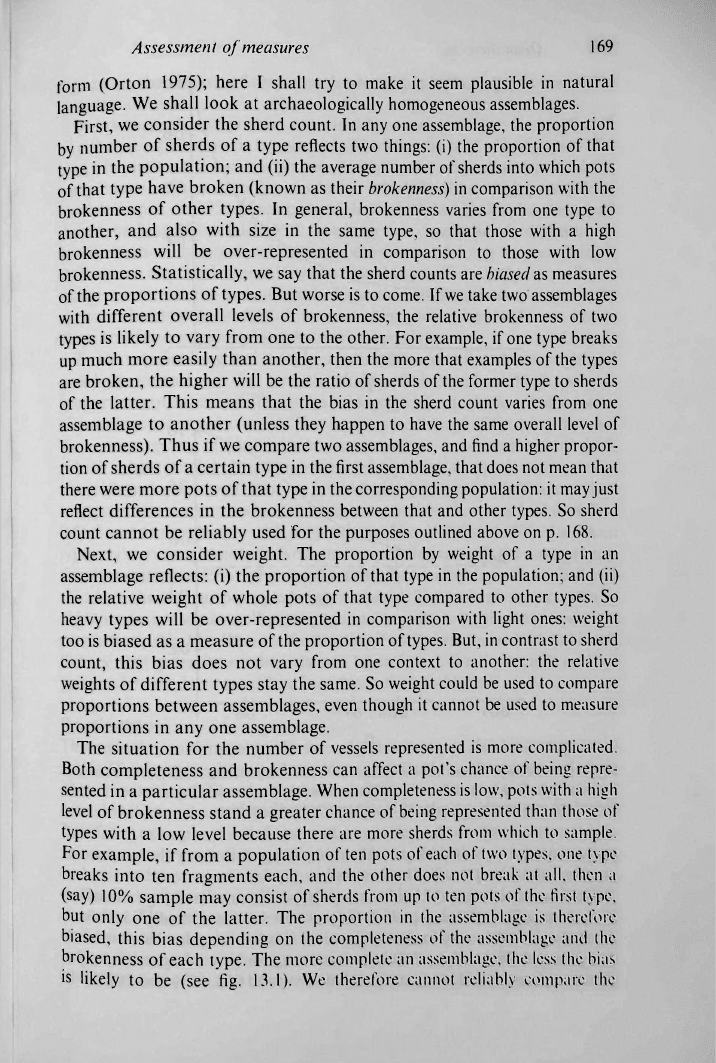
Assessment of measures
169
form (Orton 1975); here I shall try to make it seem plausible in natural
language. We shall look at archaeologically homogeneous assemblages.
First, we consider the sherd count. In any one assemblage, the proportion
by number of sherds of a type reflects two things: (i) the proportion of that
type in the population; and (ii) the average number of sherds into which pots
of that type have broken (known as their brokenness) in comparison with the
brokenness of other types. In general, brokenness varies from one type to
another, and also with size in the same type, so that those with a high
brokenness will be over-represented in comparison to those with low
brokenness. Statistically, we say that the sherd counts are biased as measures
of the proportions of types. But worse is to come. If we take two assemblages
with different overall levels of brokenness, the relative brokenness of two
types is likely to vary from one to the other. For example, if one type breaks
up much more easily than another, then the more that examples of the types
are broken, the higher will be the ratio of sherds of the former type to sherds
of the latter. This means that the bias in the sherd count varies from one
assemblage to another (unless they happen to have the same overall level of
brokenness). Thus if we compare two assemblages, and find a higher propor-
tion of sherds of a certain type in the first assemblage, that does not mean that
there were more pots of that type in the corresponding population: it may just
reflect differences in the brokenness between that and other types. So sherd
count cannot be reliably used for the purposes outlined above on p. 168.
Next, we consider weight. The proportion by weight of a type in an
assemblage reflects: (i) the proportion of that type in the population; and (ii)
the relative weight of whole pots of that type compared to other types. So
heavy types will be over-represented in comparison with light ones: weight
too is biased as a measure of the proportion of types. But, in contrast to sherd
count, this bias does not vary from one context to another: the relative
weights of different types stay the same. So weight could be used to compare
proportions between assemblages, even though it cannot be used to measure
proportions in any one assemblage.
The situation for the number of vessels represented is more complicated.
Both completeness and brokenness can affect a pot's chance of being repre-
sented in a particular assemblage. When completeness is low, pots with a high
level of brokenness stand a greater chance of being represented than those of
types with a low level because there are more sherds from which to sample.
For example, if from a population of ten pots of each of two types, one type
breaks into ten fragments each, and the other does not break at all, then a
(say) 10% sample may consist of sherds from up to ten pots of the first type,
but only one of the latter. The proportion in the assemblage is therefore
biased, this bias depending on the completeness of the assemblage and the
brokenness of each type. The more complete an assemblage, the less the bias
is likely to be (see fig. 13.1). We therefore cannot reliably compare the
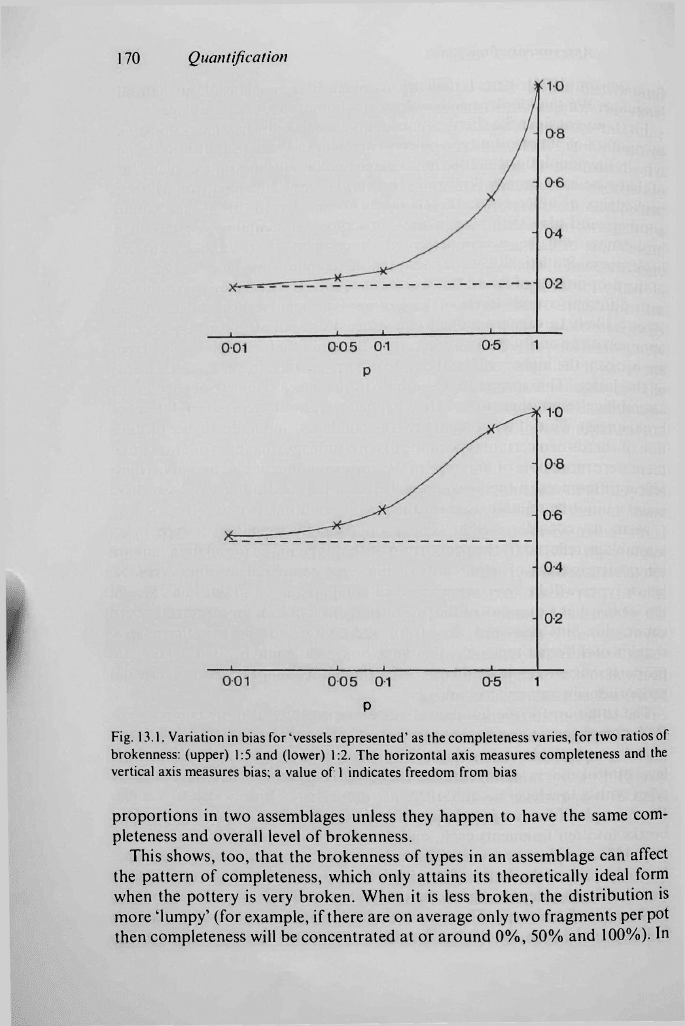
170 Quantification
P
Fig. 13.1. Variation in bias for 'vessels represented' as the completeness varies, for two ratios of
brokenness: (upper) 1:5 and (lower) 1:2. The horizontal axis measures completeness and the
vertical axis measures bias; a value of
1
indicates freedom from bias
proportions in two assemblages unless they happen to have the same com-
pleteness and overall level of brokenness.
This shows, too, that the brokenness of types in an assemblage can affect
the pattern of completeness, which only attains its theoretically ideal form
when the pottery is very broken. When it is less broken, the distribution is
more 'lumpy' (for example, if there are on average only two fragments per pot
then completeness will be concentrated at or around 0%, 50% and 100%). In
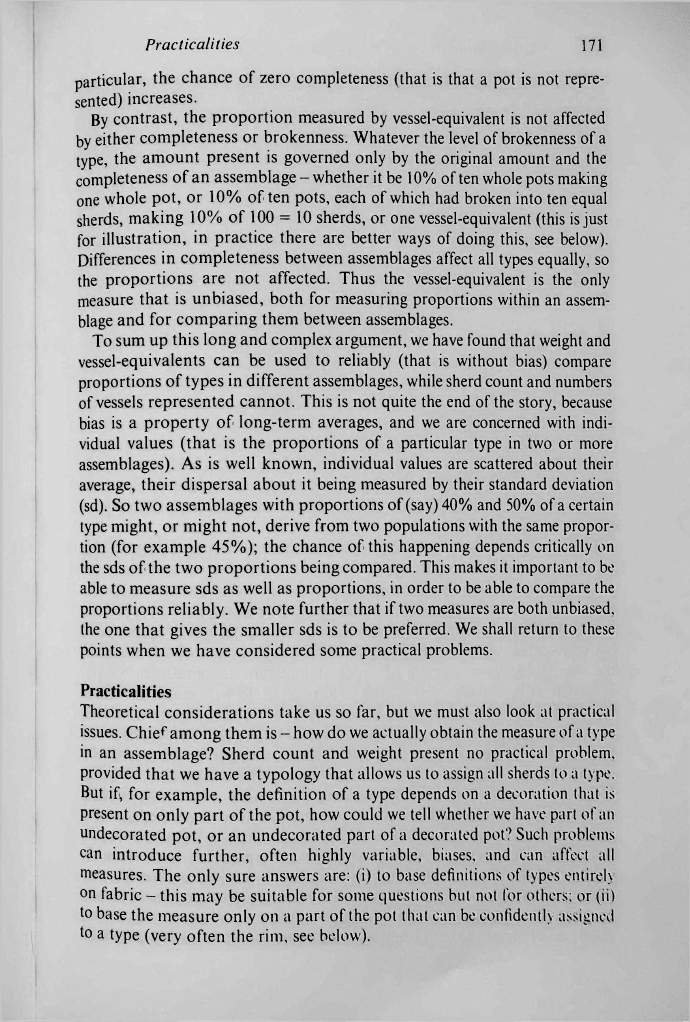
Practicalities
171
particular, the chance of zero completeness (that is that a pot is not repre-
sented) increases.
By contrast, the proportion measured by vessel-equivalent is not affected
by either completeness or brokenness. Whatever the level of brokenness of a
type, the amount present is governed only by the original amount and the
completeness of an assemblage - whether it be 10% of ten whole pots making
one whole pot, or 10% of ten pots, each of which had broken into ten equal
sherds, making 10% of 100 = 10 sherds, or one vessel-equivalent (this
is
just
for illustration, in practice there are better ways of doing this, see below).
Differences in completeness between assemblages affect all types equally, so
the proportions are not affected. Thus the vessel-equivalent is the only
measure that is unbiased, both for measuring proportions within an assem-
blage and for comparing them between assemblages.
To sum up this long and complex argument,
we
have found that weight and
vessel-equivalents can be used to reliably (that is without bias) compare
proportions of types in different assemblages, while sherd count and numbers
of vessels represented cannot. This is not quite the end of the story, because
bias is a property of long-term averages, and we are concerned with indi-
vidual values (that is the proportions of a particular type in two or more
assemblages). As is well known, individual values are scattered about their
average, their dispersal about it being measured by their standard deviation
(sd). So two assemblages with proportions of (say) 40% and 50% of a certain
type might, or might not, derive from two populations with the same propor-
tion (for example 45%); the chance of this happening depends critically on
the sds of the two proportions being compared. This makes it important to be
able to measure sds as well as proportions, in order to be able to compare the
proportions reliably. We note further that if two measures are both unbiased,
the one that gives the smaller sds is to be preferred. We shall return to these
points when we have considered some practical problems.
Practicalities
Theoretical considerations take us so far, but we must also look at practical
issues. Chief among them is - how do we actually obtain the measure of a type
in an assemblage? Sherd count and weight present no practical problem,
provided that we have a typology that allows us to assign all sherds to a type.
But if, for example, the definition of a type depends on a decoration that is
present on only part of the pot, how could we tell whether we have part of an
undecorated pot, or an undecorated part of
a
decorated pot? Such problems
can introduce further, often highly variable, biases, and can affect all
measures. The only sure answers are: (i) to base definitions of types entirely
on fabric - this may be suitable for some questions but not for others; or (ii)
to base the measure only on a part of the pot that can be confidently assigned
to a type (very often the rim, see below).
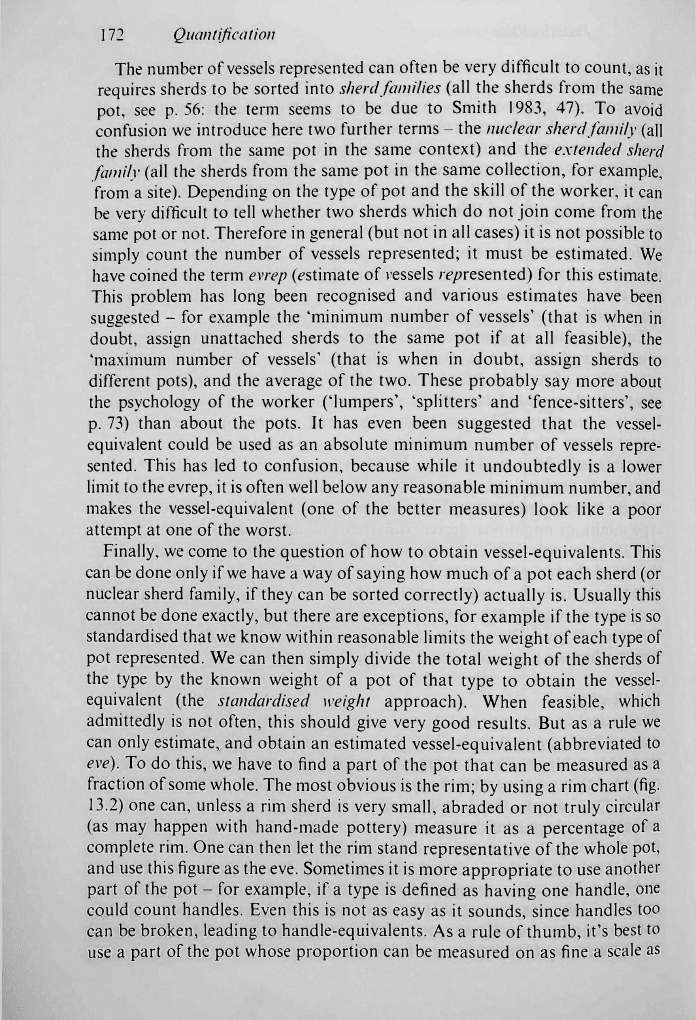
172 Quantification
The number of vessels represented can often be very difficult to count, as it
requires sherds to be sorted into sherd families (all the sherds from the same
pot, see p. 56: the term seems to be due to Smith 1983, 47). To avoid
confusion we introduce here two further terms - the nuclear sherd family (all
the sherds from the same pot in the same context) and the extended sherd
family (all the sherds from the same pot in the same collection, for example,
from a site). Depending on the type of pot and the skill of the worker, it can
be very difficult to tell whether two sherds which do not join come from the
same pot or not. Therefore in general (but not in all cases) it is not possible to
simply count the number of vessels represented; it must be estimated. We
have coined the term evrep (estimate of vessels represented) for this estimate.
This problem has long been recognised and various estimates have been
suggested - for example the 'minimum number of vessels' (that is when in
doubt, assign unattached sherds to the same pot if at all feasible), the
'maximum number of vessels' (that is when in doubt, assign sherds to
different pots), and the average of the two. These probably say more about
the psychology of the worker ('lumpers', 'splitters' and 'fence-sitters', see
p. 73) than about the pots. It has even been suggested that the vessel-
equivalent could be used as an absolute minimum number of vessels repre-
sented. This has led to confusion, because while it undoubtedly is a lower
limit to the evrep, it is often well below any reasonable minimum number, and
makes the vessel-equivalent (one of the better measures) look like a poor
attempt at one of the worst.
Finally, we come to the question of how to obtain vessel-equivalents. This
can be done only if we have a way of saying how much of a pot each sherd (or
nuclear sherd family, if they can be sorted correctly) actually is. Usually this
cannot be done exactly, but there are exceptions, for example if the type is so
standardised that we know within reasonable limits the weight of each type of
pot represented. We can then simply divide the total weight of the sherds of
the type by the known weight of a pot of that type to obtain the vessel-
equivalent (the standardised weight approach). When feasible, which
admittedly is not often, this should give very good results. But as a rule we
can only estimate,, and obtain an estimated vessel-equivalent (abbreviated to
eve). To do this, we have to find a part of the pot that can be measured as a
fraction of some whole. The most obvious is the rim; by using a rim chart (fig.
13.2) one can, unless a rim sherd is very small, abraded or not truly circular
(as may happen with hand-made pottery) measure it as a percentage of a
complete rim. One can then let the rim stand representative of the whole pot,
and use this figure as the eve. Sometimes it is more appropriate to use another
part of the pot - for example, if a type is defined as having one handle, one
could count handles. Even this is not as easy as it sounds, since handles too
can be broken, leading to handle-equivalents. As a rule of thumb, it's best to
use a part of the pot whose proportion can be measured on as fine a scale as
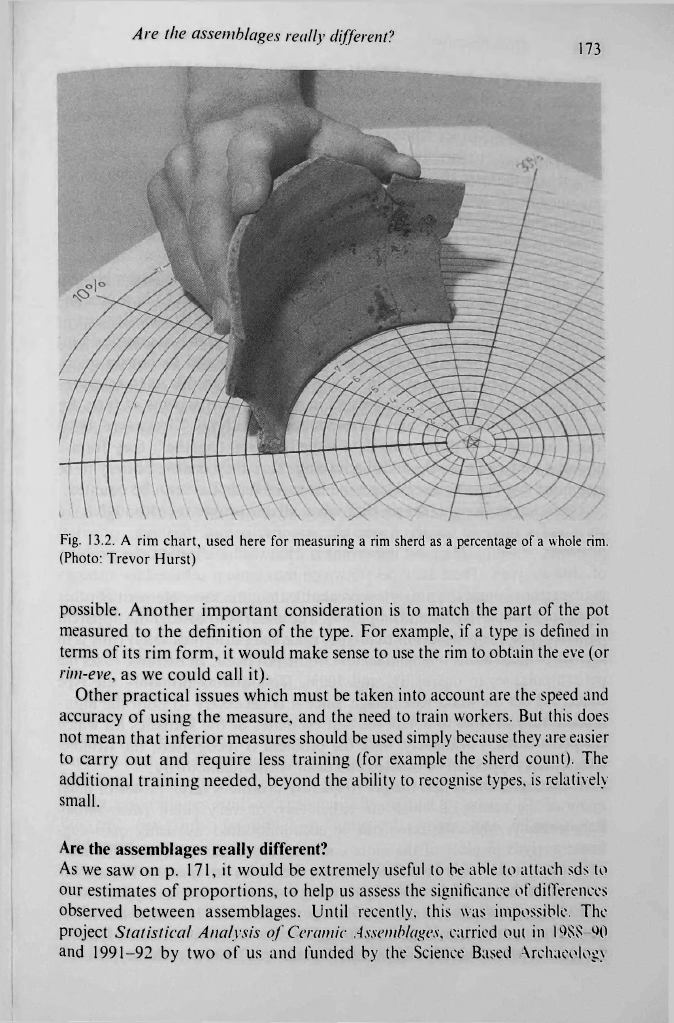
Are the assemblages really different? ^
Fig. 13.2. A rim chart, used here for measuring a rim sherd as a percentage of a whole rim.
(Photo: Trevor Hurst)
possible. Another important consideration is to match the part of the pot
measured to the definition of the type. For example, if a type is defined in
terms of its rim form, it would make sense to use the rim to obtain the eve (or
rim-eve, as we could call it).
Other practical issues which must be taken into account are the speed and
accuracy of using the measure, and the need to train workers. But this does
not mean that inferior measures should be used simply because they are easier
to carry out and require less training (for example the sherd count). The
additional training needed, beyond the ability to recognise types, is relatively
small.
Are the assemblages really different?
As we saw on p. 171, it would be extremely useful to be able to attach sds to
our estimates of proportions, to help us assess the significance of
differences
observed between assemblages. Until recently, this was impossible. The
project Statistical Analysis of Ceramic Assemblages, carried out in 1988-%
and 1991-92 by two of us and funded by the Science Based Archaeology
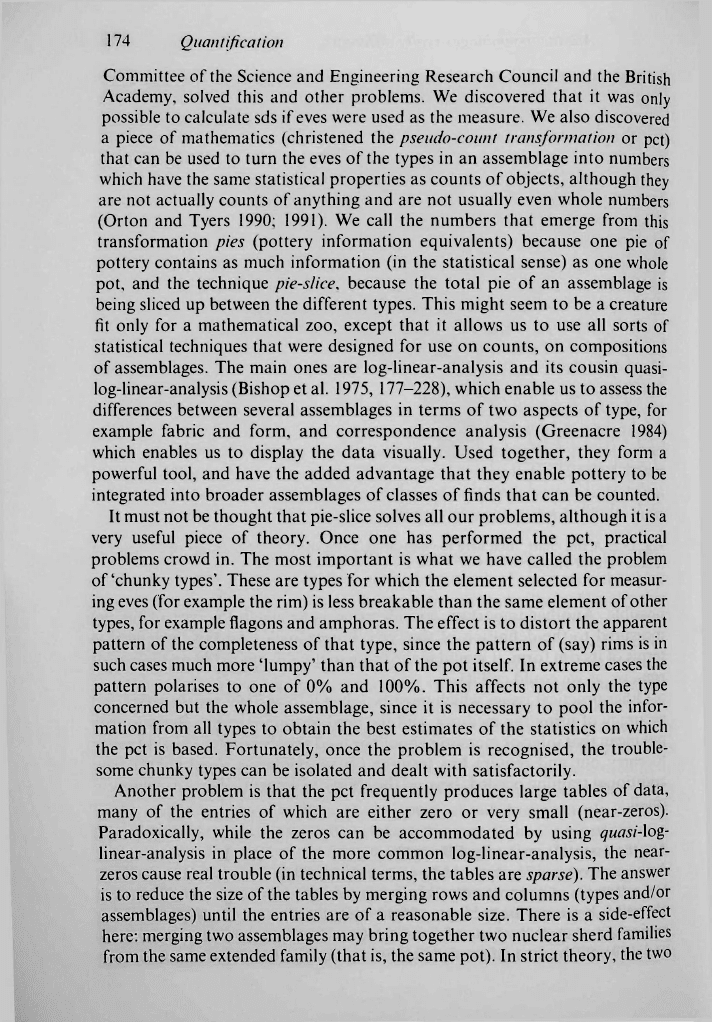
174 Quantification
Committee of the Science and Engineering Research Council and the British
Academy, solved this and other problems. We discovered that it was only
possible to calculate sds if eves were used as the measure. We also discovered
a piece of mathematics (christened the pseudo-count transformation or pet)
that can be used to turn the eves of the types in an assemblage into numbers
which have the same statistical properties as counts of objects, although they
are not actually counts of anything and are not usually even whole numbers
(Orton and Tyers 1990; 1991). We call the numbers that emerge from this
transformation pies (pottery information equivalents) because one pie of
pottery contains as much information (in the statistical sense) as one whole
pot, and the technique pie-slice, because the total pie of an assemblage is
being sliced up between the different types. This might seem to be a creature
fit only for a mathematical zoo, except that it allows us to use all sorts of
statistical techniques that were designed for use on counts, on compositions
of assemblages. The main ones are log-linear-analysis and its cousin quasi-
log-linear-analysis (Bishop et al. 1975,177-228), which enable us to assess the
differences between several assemblages in terms of two aspects of type, for
example fabric and form, and correspondence analysis (Greenacre 1984)
which enables us to display the data visually. Used together, they form a
powerful tool, and have the added advantage that they enable pottery to be
integrated into broader assemblages of classes of finds that can be counted.
It must not be thought that pie-slice solves all our problems, although it is a
very useful piece of theory. Once one has performed the pet, practical
problems crowd in. The most important is what we have called the problem
of'chunky types'. These are types for which the element selected for measur-
ing eves (for example the rim) is less breakable than the same element of other
types, for example flagons and amphoras. The effect is to distort the apparent
pattern of the completeness of that type, since the pattern of (say) rims is in
such cases much more 'lumpy' than that of the pot itself. In extreme cases the
pattern polarises to one of 0% and 100%. This affects not only the type
concerned but the whole assemblage, since it is necessary to pool the infor-
mation from all types to obtain the best estimates of the statistics on which
the pet is based. Fortunately, once the problem is recognised, the trouble-
some chunky types can be isolated and dealt with satisfactorily.
Another problem is that the pet frequently produces large tables of data,
many of the entries of which are either zero or very small (near-zeros).
Paradoxically, while the zeros can be accommodated by using quasi-log-
linear-analysis in place of the more common log-linear-analysis, the near-
zeros cause real trouble (in technical terms, the tables are sparse). The answer
is to reduce the size of the tables by merging rows and columns (types and/or
assemblages) until the entries are of a reasonable size. There is a side-effect
here: merging two assemblages may bring together two nuclear sherd families
from the same extended family (that is, the same pot). In strict theory, the two
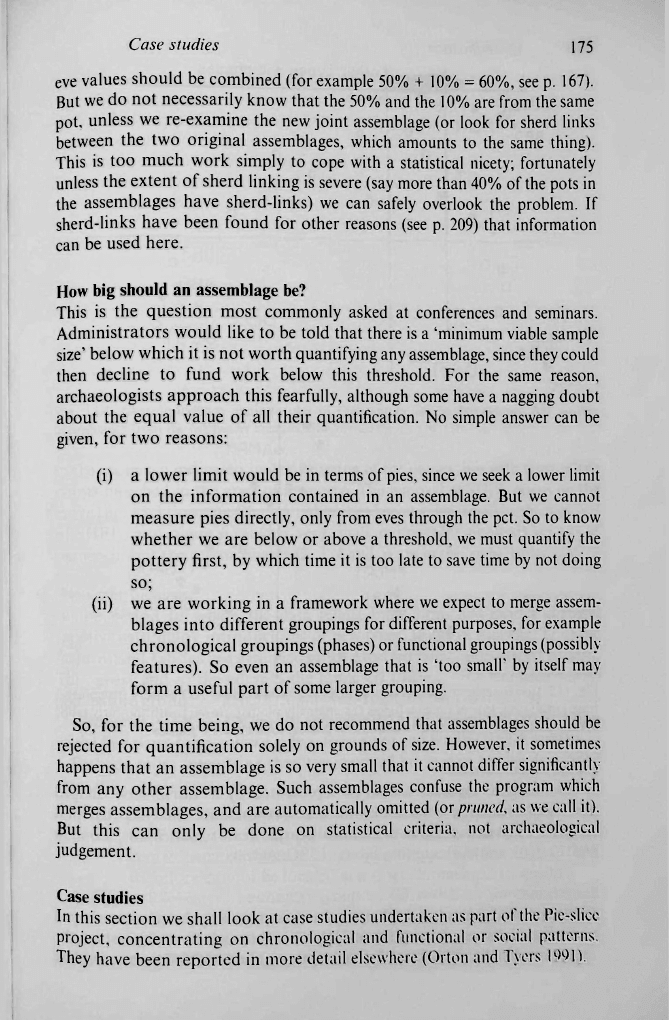
Case studies
175
eve values should be combined (for example 50% + 10% = 60%, see p. 167).
But we do not necessarily know that the 50% and the 10% are from the same
pot, unless we re-examine the new joint assemblage (or look for sherd links
between the two original assemblages, which amounts to the same thing).
This is too much work simply to cope with a statistical nicety; fortunately
unless the extent of sherd linking is severe (say more than 40% of the pots in
the assemblages have sherd-links) we can safely overlook the problem. If
sherd-links have been found for other reasons (see p. 209) that information
can be used here.
How big should an assemblage be?
This is the question most commonly asked at conferences and seminars.
Administrators would like to be told that there is a 'minimum viable sample
size' below which it is not worth quantifying any assemblage, since they could
then decline to fund work below this threshold. For the same reason,
archaeologists approach this fearfully, although some have a nagging doubt
about the equal value of all their quantification. No simple answer can be
given, for two reasons:
(i) a lower limit would be in terms of pies, since we seek a lower limit
on the information contained in an assemblage. But we cannot
measure pies directly, only from eves through the pet. So to know
whether we are below or above a threshold, we must quantify the
pottery first, by which time it is too late to save time by not doing
so;
(ii) we are working in a framework where we expect to merge assem-
blages into different groupings for different purposes, for example
chronological groupings (phases) or
functional
groupings (possibly
features). So even an assemblage that is 'too small' by itself may
form a useful part of some larger grouping.
So, for the time being, we do not recommend that assemblages should be
rejected for quantification solely on grounds of size. However, it sometimes
happens that an assemblage is so very small that it cannot differ significantly
from any other assemblage. Such assemblages confuse the program which
merges assemblages, and are automatically omitted (or
pruned,
as we call it).
But this can only be done on statistical criteria, not archaeological
judgement.
Case studies
In this section we shall look at case studies undertaken as part of the Pie-slice
project, concentrating on chronological and functional or social patterns.
They have been reported in more detail elsewhere (Orton and Tyers 1991).
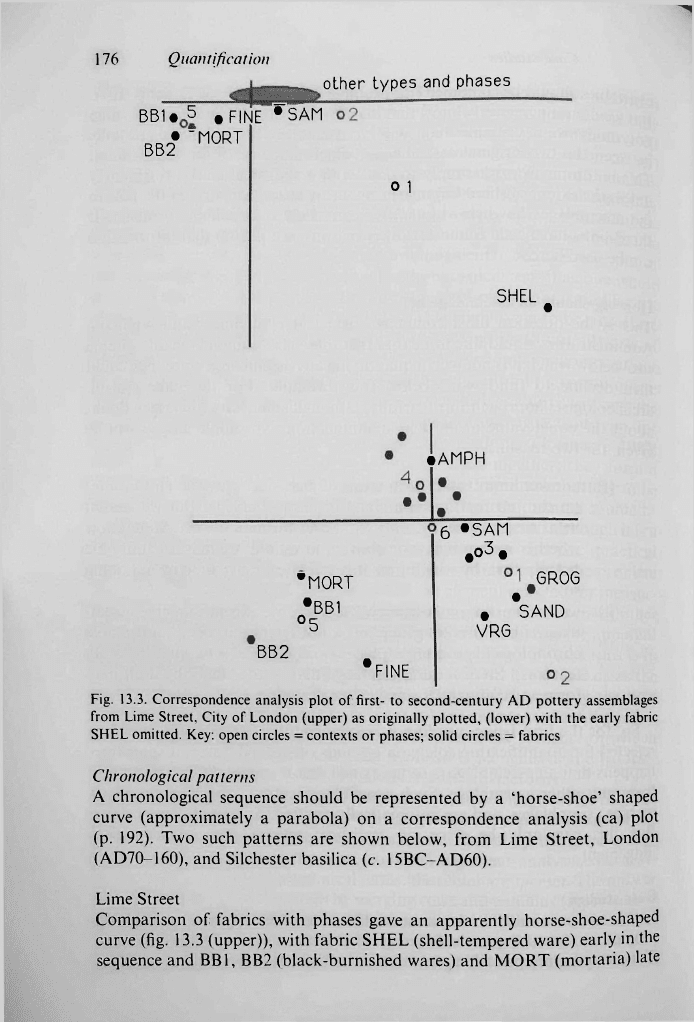
176
Quantification
other types and phases
BB1«5 .FlNE^SAM
bb2
# m
°
rt
o 1
shel
#
•amph
•mort
•BB1
°5
bb2
•fine
6 •sam
#
o3
#
grog
9
#
sand
vrg
Fig. 13.3. Correspondence analysis plot of first- to second-century AD pottery assemblages
from Lime Street, City of London (upper) as originally plotted, (lower) with the early fabric
SHEL omitted. Key: open circles = contexts or phases; solid circles
—
fabrics
Chronological patterns
A chronological sequence should be represented by a 'horse-shoe' shaped
curve (approximately a parabola) on a correspondence analysis (ca) plot
(p. 192). Two such patterns are shown below, from Lime Street, London
(AD70-160), and Silchester basilica (c. 15BC-AD60).
Lime Street
Comparison of fabrics with phases gave an apparently horse-shoe-shaped
curve (fig. 13.3 (upper)), with fabric SHEL (shell-tempered ware) early in the
sequence and BB1, BB2 (black-burnished wares) and MORT (mortaria) late
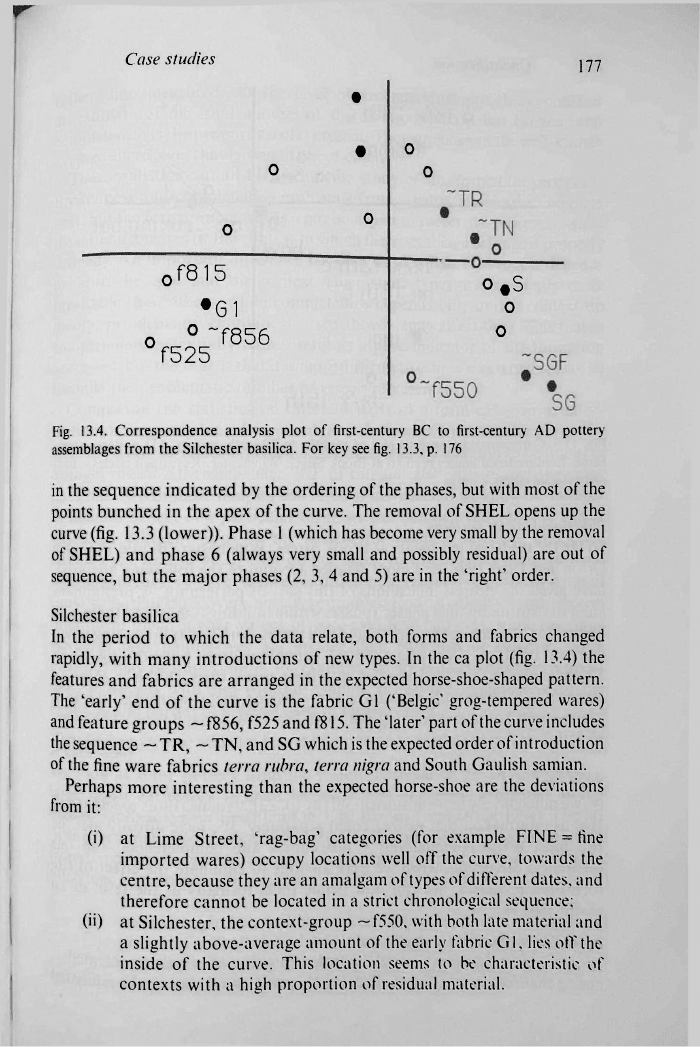
Case studies
177
t
• 0
o
0
o f815
•61
o
0
o
#
S
o
0
~f856
f525
o
o
Fig. 13.4. Correspondence analysis plot of first-century BC to first-century AD pottery
assemblages from the Silchester basilica. For key see fig. 13.3, p. 176
in the sequence indicated by the ordering of the phases, but with most of the
points bunched in the apex of the curve. The removal of SHEL opens up the
curve
(fig.
13.3 (lower)). Phase
1
(which has become very small by the removal
of SHEL) and phase 6 (always very small and possibly residual) are out of
sequence, but the major phases (2, 3, 4 and 5) are in the 'right' order.
Silchester basilica
In the period to which the data relate, both forms and fabrics changed
rapidly, with many introductions of new types. In the ca plot (fig. 13.4) the
features and fabrics are arranged in the expected horse-shoe-shaped pattern.
The 'early' end of the curve is the fabric G1 ('Belgic' grog-tempered wares)
and feature groups ~
f856,
f525 and
f815.
The 'later' part of the curve includes
the
sequence S TR, ~ TN, and SG which is the expected order of introduction
of the fine ware fabrics terra rubra, terra nigra and South Gaulish samian.
Perhaps more interesting than the expected horse-shoe are the deviations
from it:
(i) at Lime Street, 'rag-bag' categories (for example FINE = fine
imported wares) occupy locations well off the curve, towards the
centre, because they are an amalgam of types of different dates, and
therefore cannot be located in a strict chronological sequence;
CO at Silchester, the context-group ~f550, with both late material and
a slightly above-average amount of the early fabric Gl, lies off the
inside of the curve. This location seems to be characteristic of
contexts with a high proportion of residual material.
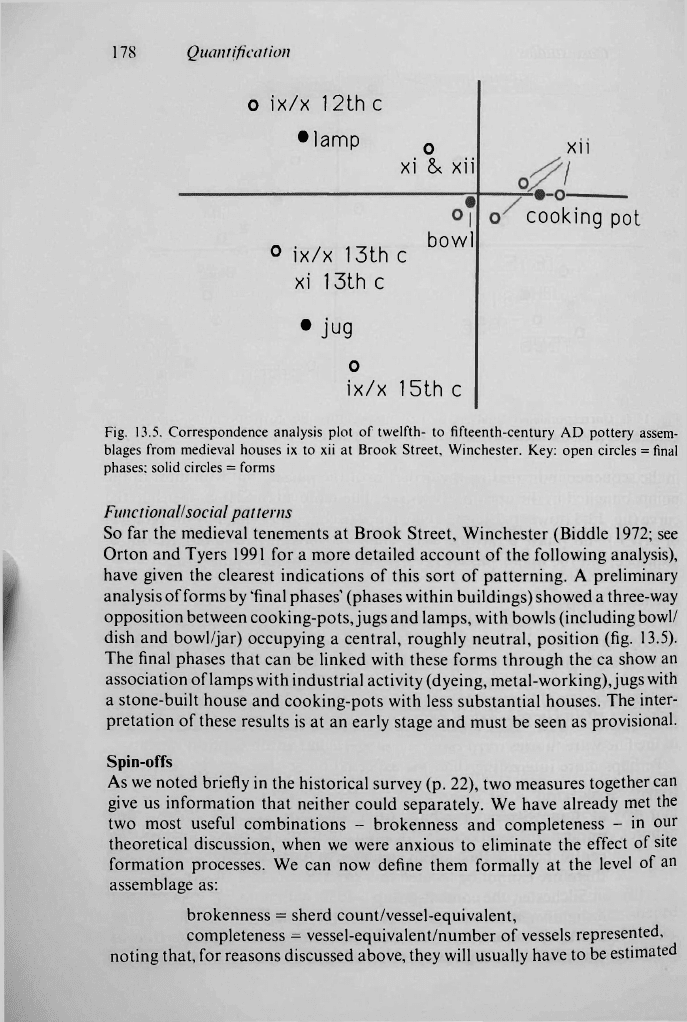
178
Quantification
o ix/x 12th
C
•lamp
o
xi & xii
0
ix/x 13th c
xi 13th c
bowl
xii
cooking pot
• jug
o
ix/x 15th c
Fig. 13.5. Correspondence analysis plot of twelfth- to fifteenth-century AD pottery assem-
blages from medieval houses ix to xii at Brook Street, Winchester. Key: open circles = final
phases; solid circles = forms
Functional!social patterns
So far the medieval tenements at Brook Street, Winchester (Biddle 1972; see
Orton and Tyers 1991 for a more detailed account of the following analysis),
have given the clearest indications of this sort of patterning. A preliminary
analysis of forms by final phases' (phases within buildings) showed a three-way
opposition between cooking-pots, jugs and lamps, with bowls (including bowl/
dish and bowl/jar) occupying a central, roughly neutral, position (fig. 13.5).
The final phases that can be linked with these forms through the ca show an
association of lamps with industrial activity (dyeing, metal-working), jugs with
a stone-built house and cooking-pots with less substantial houses. The inter-
pretation of these results is at an early stage and must be seen as provisional.
Spin-offs
As we noted briefly in the historical survey (p. 22), two measures together can
give us information that neither could separately. We have already met the
two most useful combinations - brokenness and completeness - in our
theoretical discussion, when we were anxious to eliminate the effect of site
formation processes. We can now define them formally at the level of an
assemblage as:
brokenness = sherd count/vessel-equivalent,
completeness
—
vessel-equivalent/number of vessels represented,
noting that, for reasons discussed above, they will usually have to be estimated
